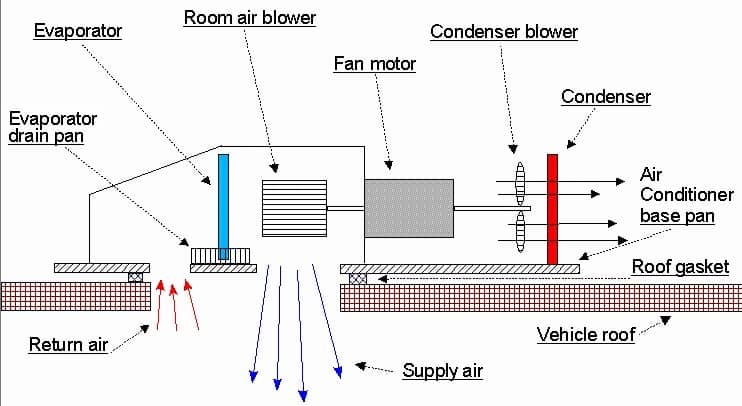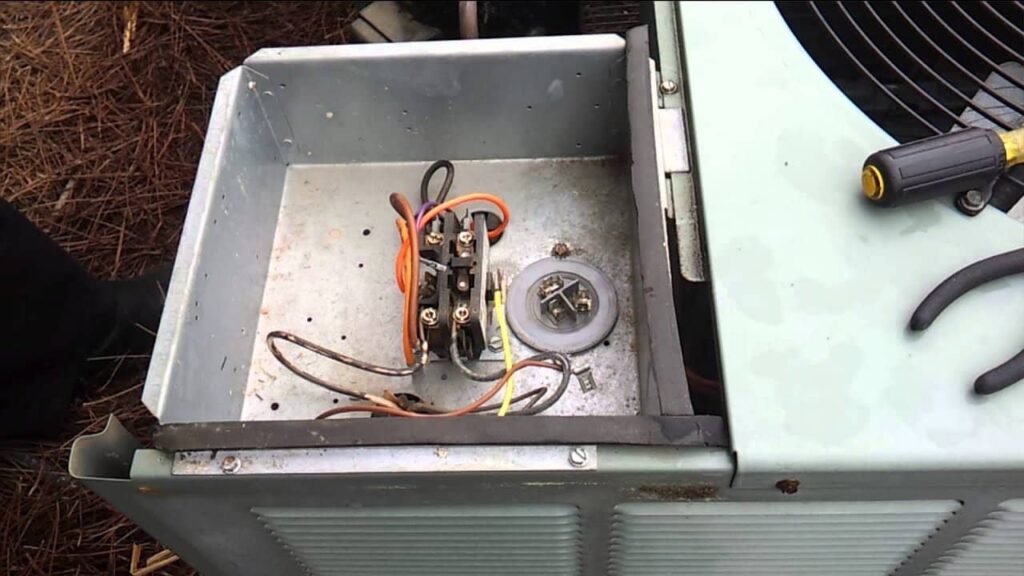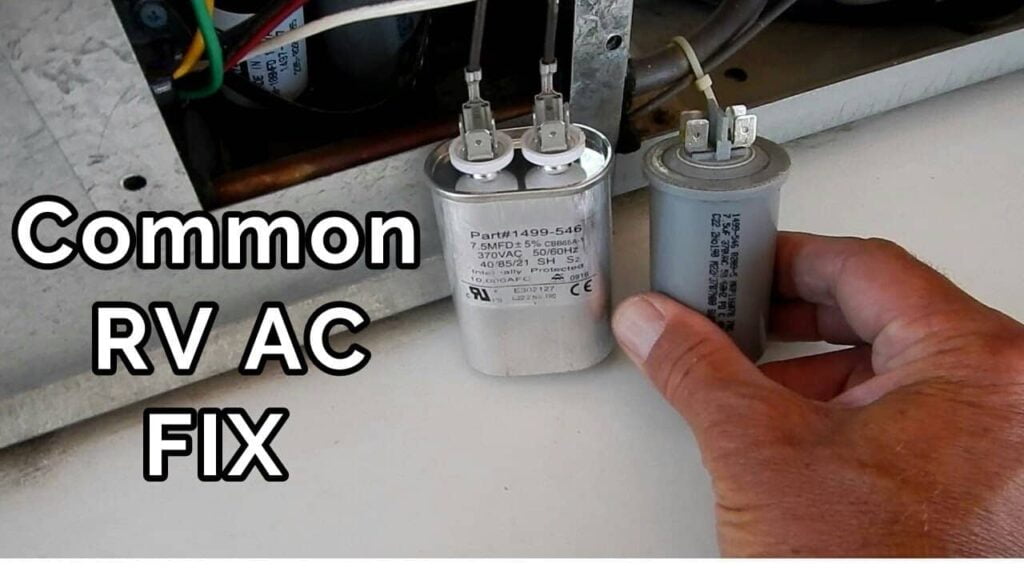When you buy through links on our site, we may earn an affiliate commission, Read More.
Having trouble with your RV air conditioner not blowing cold air? In such a case, it’s never pleasant to spend your long-awaited trip in a sweaty mess. Fortunately, there are easy solutions to save your journey from this headache.
Here I will discuss how to diagnose the problem that is preventing your AC from functioning properly. In most cases, severe AC issues need special attention from a technician. But if you have basic electronics skills, you can fix most of them with common toolsets.
With that being said, let’s jump right into it!
RV Air Conditioning Unit Fundamental

Before you start making any changes, let me give you a brief idea of how things work in your AC unit.
In general, there are two parts to this. One part is in-charge of moving air throughout your system. It pulls hot air from the outside and blows the air through various channels until it reaches your room. To do this operation correctly the system uses powerful motors and fans.
The other part handles cooling the hot air. It’s not that easy as it sounds. The cooling process involves coolant moving through several stages. First, the coolant goes through the compressor then the Evaporator, and finally the condenser.
This sequential process makes the refrigerant cold in the condenser coil. Later condensers exchange heat and transform hot air into cool air. Both parts of the unit work cooperatively to get the final result. Any disturbance in the process can hinder cooling ability, at worst stop working altogether.
On the note of refrigerant, the old RV AC unit used to run on Freon also known as R22. The use of Freon in the air conditioner is very rare at present. Mostly because of the restrictions applied to importing such chemicals. Manufacturers now use R143a instead of R22.
AC Running But Not Cooling in RV?
As explained earlier, all the parts in an AC unit work together to achieve a specific result. If any of these parts lose performance, you will face array issues. But wait, it doesn’t end here. There are other external factors behind any non-functioning RV AC component.
To get your head around the situation, let’s list all the causes that can force your camper AC to not blow cold air.
- Refrigerant leak
- Airflow issue
- Low-Quality coolant
- Bad compressor
- Water condensation
- Extremely hot atmosphere
- Control board issue
- Faulty capacitor
- Thermostat malfunction
- Clogging in the channel
- Insulation problem
RV Air Conditioner Not Blowing Cold: Each Causes With Solution

Now I will go through each cause in detail. That way you can have a broad idea of what’s going on with your unit. Furthermore, you can plan a repair with my solutions.
Keep in mind that you will be working with electrical components. So personal safety isn’t a thing you should overlook. Use Safety gloves whenever working with electronics. Lastly, if the issue is hard to find, contact the skilled technician. You don’t want to make it worse than it is now.
1. Is your refrigerant leaking?
Refrigerant leaking is a pretty common problem when your AC unit is not blowing cold air. The refrigerant in the system gets compressed by the compressor and flows through the evaporator and condenser. If there is a leak, it can result in a low coolant level.
With decreasing refrigerant, the process won’t carry out enough amounts to the condenser. As a result, the heat exchange won’t be effective. So you end up with an air conditioner not blowing cold air but running.
So, what is the simple way to detect a refrigerant leak?
The easiest way to find a leak is with an Electronic Leak Detector. This is a quite handy tool and easy to use. It has a long flexible nozzle that senses refrigerant leakage in your system. The LED on the machine lights up when it detects any leak.
2. Does The AC Unit Have Airflow Issues?
As discussed earlier, one portion of the AC unit supplies airflow. This requires a fan to spin in a specific RPM. Greater the RPM the more speed you will get. This also helps in achieving optimum airflow, which then comes out of the vent.
So, if you notice your air conditioner having a hard time delivering proper airflow, chances are your fan is the culprit.
There are many ways to fix your airflow issues.
First check the fan for dirt, grime, or other dust particles that may weigh down the propeller. Then clean the grill around the fan to give a proper intake path. Another way to free airflow is by checking the filter.
In most RV air conditioner troubleshooting cleaning only the filter makes a huge difference. In the event of a dysfunctional motor, you have to replace the fan with a new one.
3. Avoid Low-Quality Coolant
As the RV AC system is evolving with times, there are tons of options in the market when it comes to the refrigerant. People in the old days used Freon or R22. Now in most modern RV, you see R143a in use. It’s most likely for the ease of supply and more effective than the previous kind.
The quality of the refrigerant not only depends on the coolant type.
The brand name also matters that doesn’t compromise. When it’s time, changing your refrigerant to a more modern one can drastically improve the cooling performance.
4. Dealing with Bad compressor

In general, compressors last a long time without major issues. But it does need regular maintenance like cleaning. Space around the compressor tends to collect dust over time. Cleaning the dust will make sure dust particles don’t get into the compressor.
Another issue to look for in a compressor is an abnormal hissing sound. Most of the time the compressor works quietly. But internal breakdown may cause strange noise.
Take it as an early warning.
Check the power draw with a Multimeter that has a clamp that can range amp from the wire. The rating on the body spec list should match the result from the meter. If it’s higher than the rating you should immediately call an expert technician and make necessary changes.
5. Fixing Water Condensation
If you look closely into your air conditioner system, there should be a tray to collect excess water. That’s not the main problem, because the collected water will disperse once the fan pulls away through the drain pipe. But,
When water accumulates faster before it goes away, the system starts to behave unusually.
Check the coils for any filth that’s causing more water to add-in the tray. A regular inspection might help you to keep a clean coil using a Blowgun. Additionally, when RVing in the off-season, don’t forget to cover the unit so it doesn’t collect dust while idling.
6. Extremely Hot Atmosphere
No matter how powerful your ac is, it has limitations. The outside temperature plays a huge role in how an air conditioner will work comparatively. You can find even the popular Dometic AC not blowing cold in extreme heat conditions. It’s not entirely the fault of the system.
For example, the unit is capable of only bringing down the temperature to a finite number of degrees. If the temperature is much higher than the number it can compensate for, the result won’t be that effective.
You will just overdrive the system, which will eventually make it worse.
Technically there’s nothing much you can do besides buying a more powerful AC unit. Apart from that try to find a spot with shade. This might help a little.
7. Control Board Issue
The AC Control board on RV consists of various fuses, relays, capacitors, and other important components. All these parts are programmed to maintain a proper connection and relay necessary signals to the system. It’s worth a look whenever doing an RV air conditioner repair.
The board can sustain damage in several ways. As camper vans are for going places regardless of the weather condition. It’s possible, dust can build up on the circuit board. In a more humid area such as the coastline, salt condensation and developing rust is more common.
These issues are sometimes responsible for connection failure and circuits to short out.
Keep the lid closed all the time so the specks of dust can’t get in. Also, do a careful examination of rust collection.
If the breaker or fuses trigger more often, check the positive line of each fuse. Test With the Multimeter for an energy spike that causes the fuse to burnout.
8. Change Faulty Capacitor

Capacitors store energy for a brief amount of time. This electronic component has a shape like a small drum. Most electronics use capacitors to protect other vital components from under-voltage damage. In some cases, RV air conditioner problems can arise from a faulty capacitor.
We all know the AC system requires a lot of energy in its initial starting phase. The compressor also needs stable power delivery to work properly. Here the capacitor plays the role of a small battery. Whenever there is a shortage of energy due to power allocation, it maintains a stable connection for a moment.
If you have a faulty capacitor, your compressor could get hurt working under voltage.
In the case of a burnt capacitor, you will see the RV air conditioner compressor not coming on at all. Fortunately, changing the capacitor isn’t that hard. Just make sure the ratings on the body are the same when buying.
9. Placing Thermostat Correctly
The thermostat is a little device that shows all the metrics of the cooling status. It has a built-in sensor that communicates directly with the system. Every time you set a temperature level on the thermostat, the sensor evaluates the current condition and sends a signal to the unit.
According to the signal, the unit then starts the cooling process to achieve the desired temperature level. After reaching the level, the thermostat again instructs to stop working.
Fascinating right?
So now you know there’s a correlation between the thermostat and the system itself.
As an integral part of RV AC repair, skilled technicians often start with repositioning of the Thermostat. You can do the same if you are having a compressor issue. Make sure the place you selected doesn’t have any air vent or direct sunlight.
10. Clogging in The Channel
Your RV air conditioner comprises several parts all connected with copper pipes. These channels usually carry the refrigerant step by step. First, the compressor pressurizes the gas in a way that the gas becomes liquid.
In this state the liquid becomes hot. But when it goes through the evaporator coil, the pressure gets released. The liquid then becomes gas again.
According to thermodynamics, the rapid release of pressure results in temperature differences. Then newly transformed cold gas travels through the condenser coil and exchanges heat with the intake air. All these are important steps happening in each channel.
So, if dust can make their way to these channels, there is a good chance of clogging.
Because of this, you won’t get cold air. In the worst-case scenario, the RV air conditioner won’t turn on. Keeping a tight Seal around the unit does offer relief for a long time.
11. Insulation Problem
Most RV walls are thin and do not have adequate insulation around the wall. This is a beginner mistake from any new camper. So the lack of insulation eventually causes heat transmission from the outside. The heated wall then rapidly observes all the cool air from the AC.
Use the proper amount/thickness of Reflective Insulation on your wall.
Be sure to leave no opening when lining insulation sheets. After laying reflective sheets, place your wood 1-inch apart or whatever the manufacturer recommends.
Final Verdict
RV air conditioners not blowing cold is undoubtedly annoying, especially before going on a long trip. I hope after reading this article you are now well aware of the causes and now able to take action accordingly.


